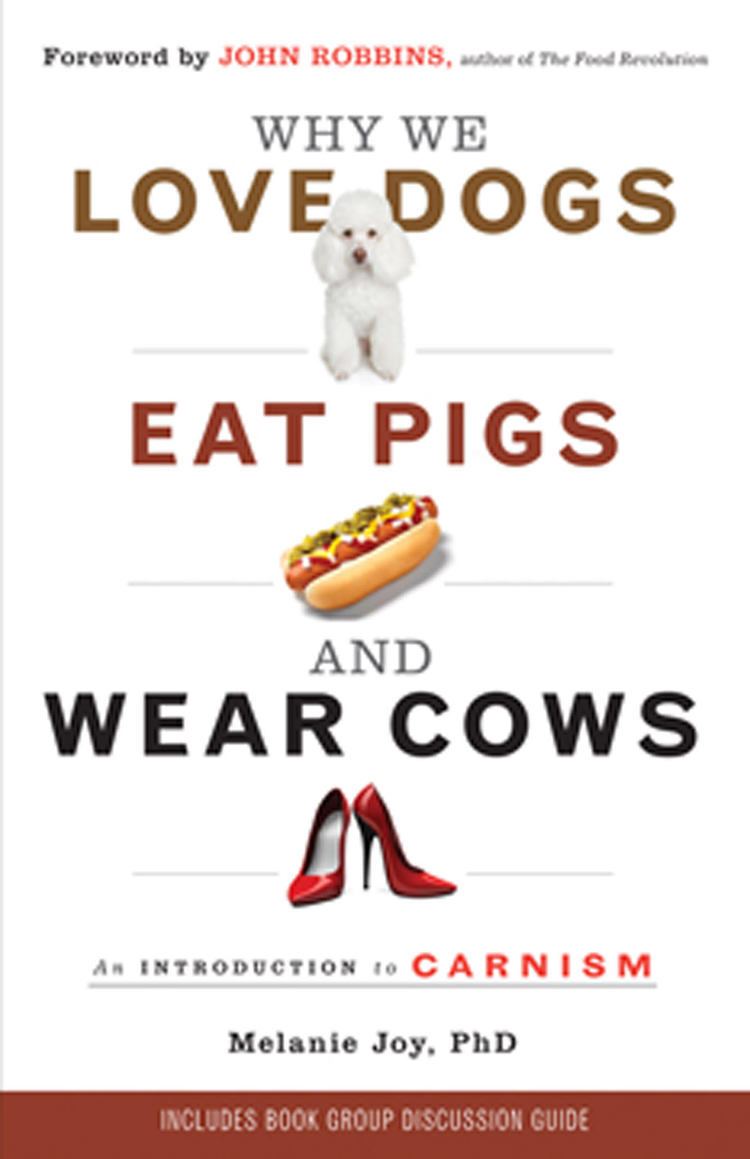8.6 /10 1 Votes8.6
4.7/5 Barnes & Noble Publication date 2009 ISBN 1-573-24461-9 Originally published 2009 Publisher Red Wheel/Weiser/Conari OCLC 316832932 | 4/5 Goodreads Subject Food & drink Pages 204 pp. Dewey Decimal 641.36 Country United States of America | |||||||||||||||||||||||||||||||||
 | ||||||||||||||||||||||||||||||||||
Media type Print (hardback & paperback) and audiobook Nutrition books Diet for a New America, Diet for a Small Planet, The Kind Diet, The China Study, Skinny Bitch | ||||||||||||||||||||||||||||||||||
why we love dogs eat pigs and wear cows an introduction to carnism book trailer
Why We Love Dogs, Eat Pigs, and Wear Cows: An Introduction to Carnism (2009) is a book by American social psychologist Melanie Joy about the belief system and psychology of meat eating, or "carnism". Joy coined the term carnism in 2001 and developed it in her doctoral dissertation in 2003. Carnism is a subset of speciesism, and contrasts with ethical veganism, the moral commitment to abstain from consuming or using meat and other animal products.
Contents
- why we love dogs eat pigs and wear cows an introduction to carnism book trailer
- Melanie joy phd demo why we love dogs eat pigs and wear cows
- Background
- Synopsis
- Critical reception
- Author interviews
- References
Melanie joy phd demo why we love dogs eat pigs and wear cows
Background
Joy, an animal advocate, was concerned about linguistic bias inherent in terms like carnivore, which were inaccurate and failed to account for the "beliefs beneath the behavior". Carnivores require meat in their diet for survival, but carnists choose to eat meat based on their beliefs. There was no label, Joy discovered, for the beliefs of people who produce, consume, and promote meat eating. She created the term carnism (Latin carn, flesh or body) to name and describe this dominant cultural belief system. "We assume that it is not necessary to assign a term to ourselves when we adhere to the mainstream way of thinking, as though its prevalence makes it an intrinsic part of life rather than a widely held opinion. Meat eating, though culturally dominant, reflects a choice that is not espoused by everybody", Joy writes.
Synopsis
Carnism, according to Joy, is the dominant, yet invisible paradigm in modern culture supporting the choice to consume meat. Carnism is an invisible system of beliefs in both the social, psychological, and physical sense. For example, in the physical sense, an estimated 10 billion land animals are slaughtered for their meat every year in the U.S., yet most of the animals are never seen—they are kept in confined animal feeding operations, invisible to the public and off limits to the media. Joy maintains that the choice to eat meat is not natural or a given as proponents of meat claim, but influenced by social conditioning. The majority of people, Joy claims, care deeply about animals and do not want them to suffer.
Joy argues there is a neurological basis for empathy; most people care about nonhuman animals and want to prevent their suffering. Further, humans value compassion, reciprocity, and justice. However, human behavior does not match these values. To continue to eat animals, Joy argues, people engage in psychic numbing, which alters the perception of our behavior towards animals and uses defense mechanisms to block empathy.
First, carnism denies there is a problem with eating animals; second, it justifies eating meat as normal, natural, and necessary; third, to prevent cognitive dissonance, carnism alters the perception of the animals as living individuals into food objects, abstractions, and categories. People who hold to these beliefs may also be called carnists.
Through this denial, justification, and perceptual distortion, Joy argues, carnism influences people to violate their core values. Animal advocates and cultural studies scholars have implicated both the government and the media as the two primary channels responsible for legitimizing carnist discourse in the United States.
Critical reception
Writer Megan Kearns agrees with Joy's argument that the system of carnism is at odds with democracy, but takes issue with Joy blaming the system rather than the people who make carnist choices: "[The] way we as a society envision eating and animals is contradictory and insidious. Yet it seems incongruous to blame the system and simultaneously hold people accountable to awaken their consciences and exercise their free will." Kearns also notes that not only are there many empathic people who choose to eat meat, but many vegetarians who base their diet on health, not moral reasons.
Helena Pedersen of Malmö University questions whether it is accurate for Joy to treat meat eaters as an homogenous group as there may be many different types of meat eaters all of whom have different reasons for eating meat. Proponents of the abolitionist theory of animal rights, such as Gary L. Francione, do not accept the concept of carnism as they believe it indirectly supports the animal welfare position by neglecting to call for the immediate rejection of all animal use and for not explicitly promoting veganism.
The book has also been released in a German edition, Warum wir Hunde lieben, Schweine essen und Kühe anziehen: Karnismus - eine Einführung.
Author interviews
I wrote Why We Love Dogs... for both carnists and veg*ns.
And though I don't use the phrase 'animal rights' I certainly do argue that one species' desire should not trump another species' right to live free from harm.
Later I turned my dissertation into a book for a lay audience.
